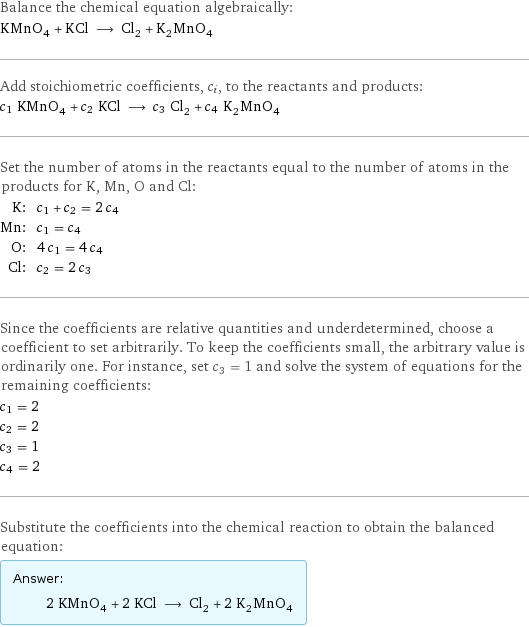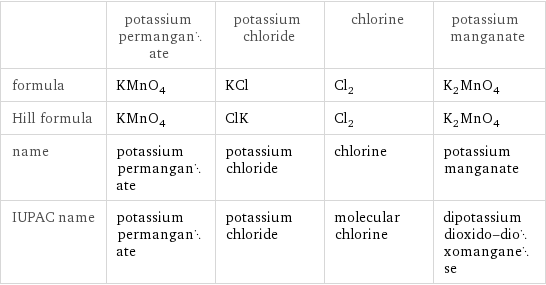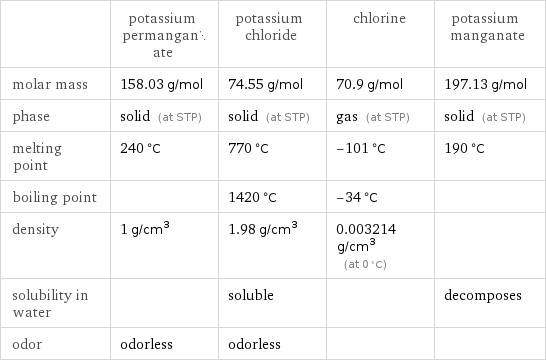Input interpretation

KMnO_4 potassium permanganate + KCl potassium chloride ⟶ Cl_2 chlorine + K_2MnO_4 potassium manganate
Balanced equation

Balance the chemical equation algebraically: KMnO_4 + KCl ⟶ Cl_2 + K_2MnO_4 Add stoichiometric coefficients, c_i, to the reactants and products: c_1 KMnO_4 + c_2 KCl ⟶ c_3 Cl_2 + c_4 K_2MnO_4 Set the number of atoms in the reactants equal to the number of atoms in the products for K, Mn, O and Cl: K: | c_1 + c_2 = 2 c_4 Mn: | c_1 = c_4 O: | 4 c_1 = 4 c_4 Cl: | c_2 = 2 c_3 Since the coefficients are relative quantities and underdetermined, choose a coefficient to set arbitrarily. To keep the coefficients small, the arbitrary value is ordinarily one. For instance, set c_3 = 1 and solve the system of equations for the remaining coefficients: c_1 = 2 c_2 = 2 c_3 = 1 c_4 = 2 Substitute the coefficients into the chemical reaction to obtain the balanced equation: Answer: | | 2 KMnO_4 + 2 KCl ⟶ Cl_2 + 2 K_2MnO_4
Structures

+ ⟶ +
Names

potassium permanganate + potassium chloride ⟶ chlorine + potassium manganate
Equilibrium constant
![Construct the equilibrium constant, K, expression for: KMnO_4 + KCl ⟶ Cl_2 + K_2MnO_4 Plan: • Balance the chemical equation. • Determine the stoichiometric numbers. • Assemble the activity expression for each chemical species. • Use the activity expressions to build the equilibrium constant expression. Write the balanced chemical equation: 2 KMnO_4 + 2 KCl ⟶ Cl_2 + 2 K_2MnO_4 Assign stoichiometric numbers, ν_i, using the stoichiometric coefficients, c_i, from the balanced chemical equation in the following manner: ν_i = -c_i for reactants and ν_i = c_i for products: chemical species | c_i | ν_i KMnO_4 | 2 | -2 KCl | 2 | -2 Cl_2 | 1 | 1 K_2MnO_4 | 2 | 2 Assemble the activity expressions accounting for the state of matter and ν_i: chemical species | c_i | ν_i | activity expression KMnO_4 | 2 | -2 | ([KMnO4])^(-2) KCl | 2 | -2 | ([KCl])^(-2) Cl_2 | 1 | 1 | [Cl2] K_2MnO_4 | 2 | 2 | ([K2MnO4])^2 The equilibrium constant symbol in the concentration basis is: K_c Mulitply the activity expressions to arrive at the K_c expression: Answer: | | K_c = ([KMnO4])^(-2) ([KCl])^(-2) [Cl2] ([K2MnO4])^2 = ([Cl2] ([K2MnO4])^2)/(([KMnO4])^2 ([KCl])^2)](../image_source/8af74df3347e8211438460f313a4c079.png)
Construct the equilibrium constant, K, expression for: KMnO_4 + KCl ⟶ Cl_2 + K_2MnO_4 Plan: • Balance the chemical equation. • Determine the stoichiometric numbers. • Assemble the activity expression for each chemical species. • Use the activity expressions to build the equilibrium constant expression. Write the balanced chemical equation: 2 KMnO_4 + 2 KCl ⟶ Cl_2 + 2 K_2MnO_4 Assign stoichiometric numbers, ν_i, using the stoichiometric coefficients, c_i, from the balanced chemical equation in the following manner: ν_i = -c_i for reactants and ν_i = c_i for products: chemical species | c_i | ν_i KMnO_4 | 2 | -2 KCl | 2 | -2 Cl_2 | 1 | 1 K_2MnO_4 | 2 | 2 Assemble the activity expressions accounting for the state of matter and ν_i: chemical species | c_i | ν_i | activity expression KMnO_4 | 2 | -2 | ([KMnO4])^(-2) KCl | 2 | -2 | ([KCl])^(-2) Cl_2 | 1 | 1 | [Cl2] K_2MnO_4 | 2 | 2 | ([K2MnO4])^2 The equilibrium constant symbol in the concentration basis is: K_c Mulitply the activity expressions to arrive at the K_c expression: Answer: | | K_c = ([KMnO4])^(-2) ([KCl])^(-2) [Cl2] ([K2MnO4])^2 = ([Cl2] ([K2MnO4])^2)/(([KMnO4])^2 ([KCl])^2)
Rate of reaction
![Construct the rate of reaction expression for: KMnO_4 + KCl ⟶ Cl_2 + K_2MnO_4 Plan: • Balance the chemical equation. • Determine the stoichiometric numbers. • Assemble the rate term for each chemical species. • Write the rate of reaction expression. Write the balanced chemical equation: 2 KMnO_4 + 2 KCl ⟶ Cl_2 + 2 K_2MnO_4 Assign stoichiometric numbers, ν_i, using the stoichiometric coefficients, c_i, from the balanced chemical equation in the following manner: ν_i = -c_i for reactants and ν_i = c_i for products: chemical species | c_i | ν_i KMnO_4 | 2 | -2 KCl | 2 | -2 Cl_2 | 1 | 1 K_2MnO_4 | 2 | 2 The rate term for each chemical species, B_i, is 1/ν_i(Δ[B_i])/(Δt) where [B_i] is the amount concentration and t is time: chemical species | c_i | ν_i | rate term KMnO_4 | 2 | -2 | -1/2 (Δ[KMnO4])/(Δt) KCl | 2 | -2 | -1/2 (Δ[KCl])/(Δt) Cl_2 | 1 | 1 | (Δ[Cl2])/(Δt) K_2MnO_4 | 2 | 2 | 1/2 (Δ[K2MnO4])/(Δt) (for infinitesimal rate of change, replace Δ with d) Set the rate terms equal to each other to arrive at the rate expression: Answer: | | rate = -1/2 (Δ[KMnO4])/(Δt) = -1/2 (Δ[KCl])/(Δt) = (Δ[Cl2])/(Δt) = 1/2 (Δ[K2MnO4])/(Δt) (assuming constant volume and no accumulation of intermediates or side products)](../image_source/abe20037a395c059f2ab47440be3960a.png)
Construct the rate of reaction expression for: KMnO_4 + KCl ⟶ Cl_2 + K_2MnO_4 Plan: • Balance the chemical equation. • Determine the stoichiometric numbers. • Assemble the rate term for each chemical species. • Write the rate of reaction expression. Write the balanced chemical equation: 2 KMnO_4 + 2 KCl ⟶ Cl_2 + 2 K_2MnO_4 Assign stoichiometric numbers, ν_i, using the stoichiometric coefficients, c_i, from the balanced chemical equation in the following manner: ν_i = -c_i for reactants and ν_i = c_i for products: chemical species | c_i | ν_i KMnO_4 | 2 | -2 KCl | 2 | -2 Cl_2 | 1 | 1 K_2MnO_4 | 2 | 2 The rate term for each chemical species, B_i, is 1/ν_i(Δ[B_i])/(Δt) where [B_i] is the amount concentration and t is time: chemical species | c_i | ν_i | rate term KMnO_4 | 2 | -2 | -1/2 (Δ[KMnO4])/(Δt) KCl | 2 | -2 | -1/2 (Δ[KCl])/(Δt) Cl_2 | 1 | 1 | (Δ[Cl2])/(Δt) K_2MnO_4 | 2 | 2 | 1/2 (Δ[K2MnO4])/(Δt) (for infinitesimal rate of change, replace Δ with d) Set the rate terms equal to each other to arrive at the rate expression: Answer: | | rate = -1/2 (Δ[KMnO4])/(Δt) = -1/2 (Δ[KCl])/(Δt) = (Δ[Cl2])/(Δt) = 1/2 (Δ[K2MnO4])/(Δt) (assuming constant volume and no accumulation of intermediates or side products)
Chemical names and formulas

| potassium permanganate | potassium chloride | chlorine | potassium manganate formula | KMnO_4 | KCl | Cl_2 | K_2MnO_4 Hill formula | KMnO_4 | ClK | Cl_2 | K_2MnO_4 name | potassium permanganate | potassium chloride | chlorine | potassium manganate IUPAC name | potassium permanganate | potassium chloride | molecular chlorine | dipotassium dioxido-dioxomanganese
Substance properties

| potassium permanganate | potassium chloride | chlorine | potassium manganate molar mass | 158.03 g/mol | 74.55 g/mol | 70.9 g/mol | 197.13 g/mol phase | solid (at STP) | solid (at STP) | gas (at STP) | solid (at STP) melting point | 240 °C | 770 °C | -101 °C | 190 °C boiling point | | 1420 °C | -34 °C | density | 1 g/cm^3 | 1.98 g/cm^3 | 0.003214 g/cm^3 (at 0 °C) | solubility in water | | soluble | | decomposes odor | odorless | odorless | |
Units
